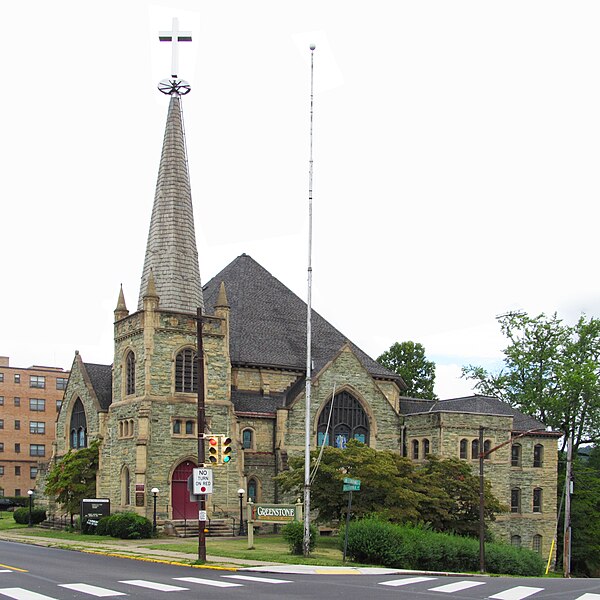
Roof, tower, and spire of Trinity Cathedral and part of the Kaufmann & Baer department store (later Gimbels, and now the Heinz 57 Center).

This church was built in 1906; the Pittsburgh History and Landmarks Foundation was unable to identify the architect, and so far Father Pitt has had no better luck. (Update: The architects are now identified as Vrydaugh & Wolfe; see the end of this article.) It used to be called the Bellevue Methodist Church—Methodist Episcopal, as opposed to Methodist Protestant, since there was one of those, too. This one is in Avalon, which used to be called West Bellevue, and its striking green stone gave it the name by which everybody called it. In 1982, the congregation bowed to the popular will and renamed the church Greenstone.
This is one of the relatively few churches of this type that have kept their spires.
The picture above is one of those rare pictures where old Pa Pitt decided to remove all the fat ugly utility cables, because they were just too distracting.


The composite picture above shows some of the matching Sunday-school wing. The stitching worked perfectly for the building, but it made a noticeable break in the car parked on the street, which you can see if you enlarge the picture. Father Pitt left a note on the windshield.
Addendum: Perhaps unsurprisingly, given the style—and especially that low tower with four corner pinnacles—this church was designed by Vrydaugh & Wolfe.1 This means that Vrydaugh & Wolfe had two of the four corners of this intersection covered: diagonally across from this church is their Church of the Epiphany.

Old Pa Pitt happened to notice that there were very few pictures in Wikimedia Commons of Chatham University, one of the most beautiful college campuses in Pittsburgh or anywhere. That omission had to be rectified. There are now thirty-two more good pictures in the Chatham University category, and we’ll be seeing many of them in the coming days. This is the chapel, a fine Colonial-revival building from 1940.


On city planning maps, Chatham is in Squirrel Hill. The University calls this the Shadyside campus. We put it in both categories.

The first structural use of aluminum was this ornate tracery spire on the Smithfield Congregational Church by Henry Hornbostel. Unfortunately the decorative stamped concrete that covers the rest of the church is crumbling, and it will cost millions to repair. The church has been shrouded in mesh for years now, but the spire still proudly catches the early-morning sun.

Here is a huge picture of the front of St. Mary of the Mount on Grandview Avenue, Mount Washington. It’s made from eight individual pictures, all cleverly sewn together by Hugin. If you click on the picture, you can enlarge it to 4,692 × 6,569 pixels, or about 30 megapixels. (It could have been larger, but old Pa Pitt decided that 30 megapixels was probably large enough.) Many thanks to Wikimedia Commons for being willing to host huge pictures at such a level of detail.
The architect was Frederick Sauer, whose conventionally attractive churches do nothing to prepare us for the eccentric whimsy he could produce when he let his imagination run wild.